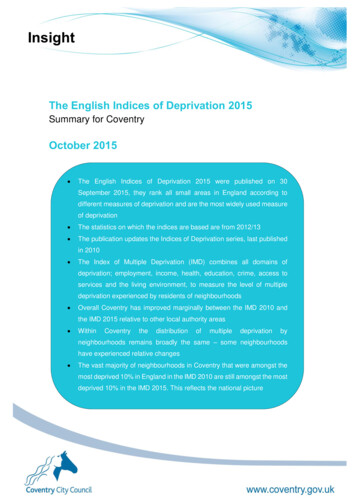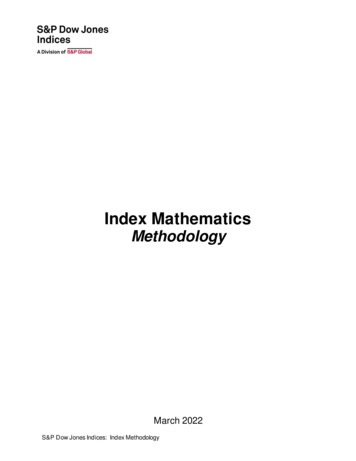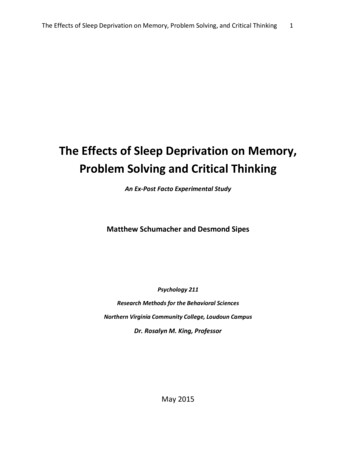
Transcription
InsightThe English Indices of Deprivation 2015Summary for CoventryOctober 2015 The English Indices of Deprivation 2015 were published on 30September 2015, they rank all small areas in England according todifferent measures of deprivation and are the most widely used measureof deprivation The statistics on which the indices are based are from 2012/13 The publication updates the Indices of Deprivation series, last publishedin 2010 The Index of Multiple Deprivation (IMD) combines all domains ofdeprivation; employment, income, health, education, crime, access toservices and the living environment, to measure the level of multipledeprivation experienced by residents of neighbourhoods Overall Coventry has improved marginally between the IMD 2010 andthe IMD 2015 relative to other local authority areas byneighbourhoods remains broadly the same – some neighbourhoodshave experienced relative changes The vast majority of neighbourhoods in Coventry that were amongst themost deprived 10% in England in the IMD 2010 are still amongst the mostdeprived 10% in the IMD 2015. This reflects the national picture1
What do the Indices of Deprivation measure?The Indices of Deprivation 2015 provide a relative measure of deprivation in small areasacross England. The Indices of Deprivation 2015 is based on a concept of deprivationthat is wider than income alone and includes a general lack of resources andopportunities.The indices are used widely to analyse patterns of deprivation, identify areas thatwould benefit from special initiatives or programmes and as a tool to determineeligibility for specific funding streams.How do the Indices work?The Indices of Deprivation 2015 is the collective name for a group of 10 indices which allmeasure different aspects of deprivation. The most widely used of these is the Index ofMultiple Deprivation (IMD) which is a combination of a number of the other indices togive an overall score for the relative level of multiple deprivation experienced in everyneighbourhood in England.In total 37 separate indicators, which are grouped into seven domains each of whichreflects a different aspect of deprivation, are used to produce an overall Index of MultipleDeprivation score for each small area in England. The domains used in the Index ofMultiple Deprivation 2015 are income, employment, health, education, crime, barriers tohousing and services and living environment. Each of these domains has their ownscores and ranks allowing users to focus on specific aspects of deprivation.All the Lower-layer Super Output Areas (LSOAs) in England (32,844) can be rankedaccording to their Index of Multiple Deprivation score; this allows users to identify themost and least deprived areas in England and to compare whether one area is moredeprived than another. There are 195 LSOAs in Coventry with an average populationof 1,700 residents. An area has a higher deprivation score than another one if theproportion of people living there who are classed as deprived is higher. A geographicalarea itself is not deprived: it is the circumstances and lifestyles of the people livingthere that affect its deprivation score.It is important to remember that not everyone living in a deprived area is deprived –andthat not all deprived people live in deprived areas.2
What can you use the Indices of Deprivation 2015 for?To compare different areas in EnglandThe Indices of Deprivation 2015 collects the same indicators and combines them in thesame way for every Lower-layer Super Output Area in England this means you candirectly compare the ranks of different areas in England. If an area has a higher rank (i.e.closer to 1) than another area it is more deprived.To identify the most deprived areas in EnglandBy using cut points of the ranks you can identify the group of Lower-layer Super OutputAreas that are amongst the most deprived in England, some common cut points thathave been used in the past are the 1%, 5%, 10% and 20% most deprived.To look at differences between the domains of deprivationUsing the domain scores and ranks you can compare which issues are the biggestconcerns for different areas.To look at deprivation across larger areasSummaries of overall deprivation are provided for local authorities. There are a numberof ways to summarise Indices of Deprivation 2015 results across larger geographicareas and the best approach will depend on the purpose of the analysis.What can’t the Indices of Deprivation 2015 be used for?There are a few ways in which it is tempting to use the index, but which do not reallymake sense or which lead to unreliable results. Tiny differences in the deprivationscores don’t mean anything. There is no point resorting to decimal places or rankdifferences of less than 100 to identify whether one area is more deprived thananother.3
Measure absolute deprivationThe Indices of Deprivation 2015 are relative measures of deprivation. This means it cantell you if one area is more deprived than another but not by how much. For example ifan area has a rank of 40 it is not necessarily half as deprived as a place with a rank of20.Measure absolute change over timeDeprivation scores cannot be compared between 2015 and 2010 because an area’sscore is affected by the scores of every other area; so it is impossible to tell whether achange in score is a real change in the deprivation level of an area, or whether it is dueto the scores of other areas going up or down.Measure affluenceThe Indices of Deprivation 2015 are not measures of affluence; all of the indicators usedin the indices are designed to identify aspects of deprivation, not affluence. Thereforethe area ranked as the least deprived is not necessarily the most affluent.Identify deprived peopleThe Indices of Deprivation 2015 measure the relative level of deprivation in an area.Within every area there will be individuals who are deprived and individuals who are not.The Indices of Deprivation 2015 are not a suitable tools for targeting individuals.Index of Multiple Deprivation at Local Authority DistrictLevelThere are four main local authority district summary scores for each Local Authoritydistrict (there are 326 districts in England), different ways of ranking local authorities interms of overall levels of deprivation. A relative ranking according to the district's level ofdeprivation is then provided.4
The summary measures at district level focus on different aspects of multiple deprivationin the area. No single measure is favoured over another, as there is no single best wayof describing or comparing districts due to the considerable differences in population sizeand distribution and the concentration of deprivation.The methodology underpinning the IMD 2004, the IMD 2007, the IMD 2010 and the IMD2015 are largely the same though there have been small changes to some of theunderlying indicators. Comparison between the indices is therefore acceptable, althoughthey should be made with care. The IMD 2015 uses statistics that were measured in2012/13 and is therefore a snapshot of deprivation in that period. The IMD 2010 usedstatistics from 2007/8 – any analysis of relative changes over that period examinechanges between a time before the UK recession hit and a time after the peak of therecession as GDP growth was returning to the economy.Key Findings for Coventry from the English Indices ofDeprivation 2015Overall position Coventry's relative position has generally improved a little compared with the Indexof Multiple Deprivation 2010. See table 1. The positive change in Coventry's deprivation rank according to most of the abovemeasures is only a relative change; this does not necessarily imply absolutechange. According to the Local Concentration measure, which ranks local authorities interms of the deprivation levels experienced by the most deprived 10% of the localpopulation, Coventry ranks as 38th most deprived – a slight improvement from 37thin the IMD 2010. This summary measure tends to highlight those local authorityareas with very highly deprived Lower-layer Super Output Areas. Looking at the proportion of Coventry’s neighbourhoods (LSOAs) that are amongstthe most deprived 10% in England, Coventry is the 46th most deprived localauthority in England. There is no comparison to the IMD 2010 using this measure. Using the Extent measure, which is a more sophisticated way of measuring theproportion of the district's population living in the most deprived LSOAs in the5
country, Coventry is ranked 55th out of the 326 Local Authority Districts (with 1being the most deprived) compared to 52nd from IMD 2010. See table 1. Using the Average of LSOA Scores, which summarises the district as a wholeincluding deprived and less deprived LSOAs, Coventry is ranked 54th out of 326compared to 50th from the IMD 2010. See table 1. Coventry ranks worse when using methods of ranking local authorities’ in terms ofthe most deprived neighbourhoods in each area and better when ranking in termsof an average of the whole area. This demonstrating inequalities that exist acrossCoventry. The deprivation domain in which Coventry is relatively most deprived is income.See table 2.Within the City 36 Lower-layer Super Output Areas (LSOAs) in Coventry are in the most 10%deprived in England (18.5% in Coventry compared to 10% across England overall).See table 3. 61 LSOAs in Coventry are in the most 20% deprived in England (31% in Coventrycompared to 20% across England overall). See table 3. There has been no significant change in the overall pattern of deprivation in the citybut the ranks of some of the city's LSOAs have changed. See maps 1 and 2. 35 Coventry LSOAs were amongst the most deprived 10% of LSOAs in Englandaccording to the IMD 2010. 32 of these are still amongst the most deprived 10% inthe IMD 2015 – 2 LSOAs moved into a less deprived category and the boundarychanged for 1 so there is no data. Overall the number of LSOAs amongst the most deprived 10% increased from 35 inthe IMD 2010 to 36 in the IMD 2015. See table 3.6
Table 1 - Coventry's relative position in the IMD over timeDomainLocalConcentrationIMD 2010Rank (1 mostDescriptiondeprived localauthority)Scoredeprived localauthority)Score37316233832041460.185This measure defines 'hot spots' ofdeprivation by reference to apercentage of the local authoritydistrict's population.Proportion of LSOAs in most deprived 10% nationallyExtentAverage ofLSOA ScoresIMD 2015Rank (1 mostUnavailableProportion of districts' populationliving in the most deprived LSOAs inthe country(broader than 10% most deprived)520.33550.32Average of the district’s scoresacross all its LSOAs5028.4405428.107Table 2 - Coventry's relative position across all domains of the Indices ofDeprivationIndices of Deprivation 2015– Coventry national rank (outof 326 local authorities)Proportion ofLSOAs in mostdeprived 10%nationallyAverage ofLSOA 054Crime8150Barriers to Housing andServices150119Living environment5849Income Deprivation AffectingChildren Index (IDACI)5748Income Deprivation AffectingOlder People Index (IDACI)31417
Table 3 - Number of Coventry's LSOAs in most deprived nationallyIMD 2010IMD 2015Number of LSOAs in10% most deprivednationally35 out of 19736 out of 195Number of LSOAs in20% most deprivednationally61 out of 19761 out of 195Map 1 - Coventry LSOAs by deprivation decile8
Map 2 - Coventry LSOAs - change in rankWhen interpreting the changes by Coventry’s local neighbourhoods (LSOAs) shown inthe map below, it should be kept in mind that all changes in the IMD ranks only showrelative changes – the map does not imply any neighbourhoods have become more orless deprived in an absolute sense, only relative to other areas. Also it should be kept inmind that rank changes of less than 1,000 are a relatively small change.Please note: rank changes can be as a result of both changes within the LSOA between the IMD 2010 andthe IMD 2015 and changes amongst LSOAs across England. The ranks in England range from 1-32,844.Small changes can have a dramatic impact on the ranking over time as many LSOAs have very similarscores.Access to the DataData from the Index of Multiple Deprivation for Coventry is available via an interactivemap on the Facts about Coventry website. Follow this hyperlink or navigate to it onwww.coventry.gov.uk/factsaboutcoventryThe national data set and report can be read by following this link.Further analysis will be conducted using the Indices of Deprivation. For help contactCoventry City Council's Insight Team on insight@coventry.gov.uk or 024 7683 39469
InsightTelephone: (024) 7683 3946Email: insight@coventry.gov.ukTelephone: (024) 7683 3946Email: insight@coventry.gov.uk10
The Index of Multiple Deprivation (IMD) combines all domains of deprivation; employment, income, health, education, crime, access to services and the living environment, to measure the level of multiple deprivation experienced by residents of neighbourhoods . e










